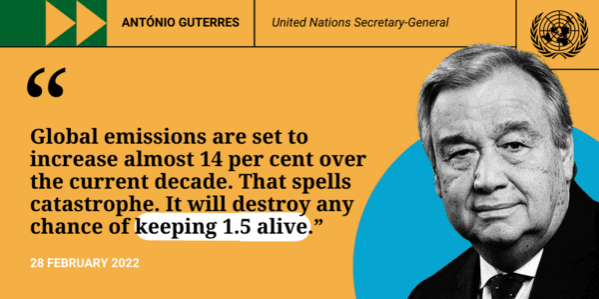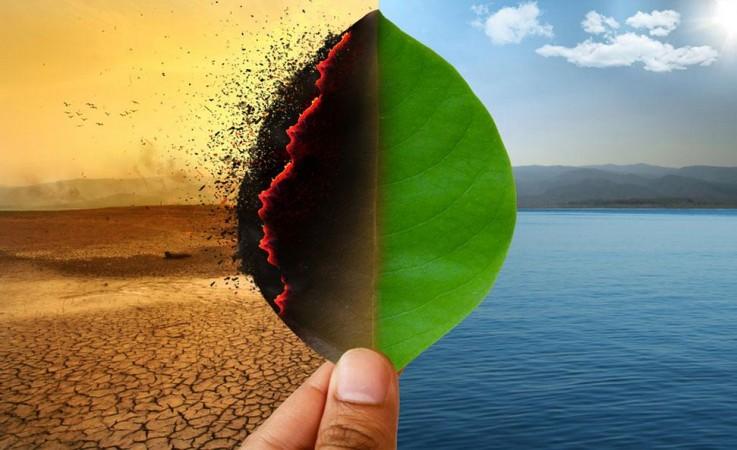Climate change panels and activists have long warned the governments, climate leaders and organisations about the consequences of looking the other way and not reducing greenhouse gas emissions. They have predicted bad and worse things. But the negative impacts of climate change are mounting faster than even the science community itself predicted and warned us of.
The IPCC Climate Report 2022
According to the latest report from United Nations Climate Panel, many impacts are unavoidable and will hit the world's most vulnerable communities the hardest.
"Human-induced climate change is causing dangerous and widespread disruption in nature and affecting the lives of billions of people around the world, despite efforts to reduce the risks, says the Intergovernmental Panel on Climate Change (IPCC) report 2022 titled Impacts, Adaptation and Vulnerability. While many impacts are unavoidable and will hit the world's most vulnerable populations hardest, but if timely, collective action is taken by the governments to curb greenhouse gas emissions and prepare communities, the worst can be averted.

The report, released on 28 February, is the second instalment of the latest climate assessment from the UN Intergovernmental Panel and has been authored by 270 researchers from 67 countries. While the first instalment was released in August last year and focused on recent climate science, this one purely assesses the hazardous impact climate change will have on communities and humankind. The third report, due early April, will list out the options for battling climate change and reducing greenhouse gas emissions.
What it says
The co-author of the report Maarten van Aalst, also a climate scientist heading the Red Cross Red Crescent Climate Centre in the Netherlands, warns of the consequences of any further delay in global action.
"The cumulative scientific evidence is unequivocal and any delay in global action on adaptation and mitigation will miss a brief and rapidly closing window of opportunity to secure a liveable and sustainable future for all." The United Nations Secretary-General Antonio Guterres, during a press conference unveiling the report, said, "I've seen many scientific reports in my time, but nothing like this."
He also added, "It is a damning indictment of failed climate leadership."

Key takeaways
The report estimates a frightening figure of 40% of the world's population to be living in places that fall under the "highly vulnerable to climate change." Especially the places where climate change directly affects sea level. For instance Bahamas, one of the low lying coastal countries that are at high-risk from climate change.
Translated into numbers, between 3.3 billion and 3.6 billion people in the world are inhabitants of places highly vulnerable to climate change. The report also says that some of the communities and places are already experiencing the adverse effects of climate change, although these effects are dependent on factors such as geography, region and socioeconomic status. The only silver lining in the report, otherwise full of warnings, happens to be the fact that additional finance, planning could help many communities be better prepared for climate change.
If temperatures continue to rise...
Frequent fires, floods and heatwaves are just very few of the manifestations of death and suffering caused by climate change around the world. Climate change, apart from causing disasters, has also affected public health in several ways, with cardiovascular and respiratory problems directly caused by smoke inhalation. Rainfall and flooding have resulted in infectious and epidemiological diseases such as cholera. This apart from the mental health issues directly associated with uncertainty, natural disasters, loss of lives and livelihood. All these problems will only continue to escalate if global temperatures continued to rise.
The report also says that if global temperatures rise by more than 1.5 degree Celsius above pre-industrial levels, some of the environmental changes could become irreversible. Further, in some areas such as forests and Arctic permafrost zones that act as carbon dioxide reservoirs, it could kick-start a self-perpetuating back and forth cycle of global warming and carbon emissions.
Time to act, now
Starting with coastal communities, they can temporarily protect themselves from extreme weather conditions such as storms by restoring coral reefs, mangroves and wetlands. Rising seas will eventually override such endeavours, result on coastal erosion, flooding and thus loss of freshwater resources. Moving on, sustainable economic development must focus on protecting biodiversity and maintaining natural ecosystems.
Why it needs to be taken seriously?
Chapter 10 of the report assesses the impact of climate change on Asia. "As the most populous continent, Asia is faced with a unique set of challenges that vary across its climatic zones." It also says, "Asian countries are experiencing a hotter summer climate, resulting in increase of energy demand for cooling at a rapid rate, together with the population growth.
Decrease in precipitation influences energy demand as well, as desalination, underground water pumping and other energy intensive methods are increasingly used for water supply. It also observed that surface air temperature has increased in the 20th century all over Asia.
At the launch of the report, World Meteorological Organisation secretary general Petteri Taalas said, "It is likely that practically all human beings on the planet will face major disasters by the end of this century."
The #IPCC released its latest #ClimateReport today, #ClimateChange 2022: Impacts, Adaptation & Vulnerability
— IPCC (@IPCC_CH) February 28, 2022
“The scientific evidence is unequivocal: #climatechange is a threat to human wellbeing & the health of the planet,” – @poertner_hans
➡️ https://t.co/sz89t4EKHj
? ⬇️ pic.twitter.com/Ol0GCPFvu7

















